Brazil Diabetes Care Devices Market Size
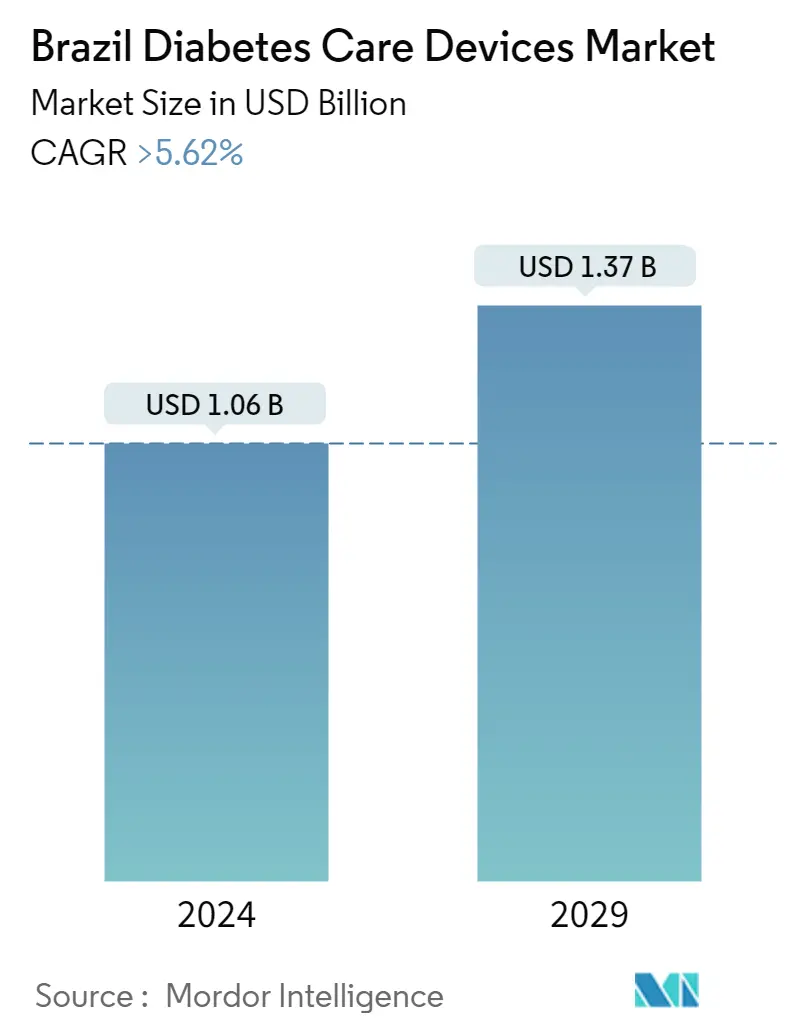
| Study Period | 2018 - 2029 |
| Base Year For Estimation | 2023 |
| Forecast Data Period | 2024 - 2029 |
| Market Size (2024) | USD 1.06 Billion |
| Market Size (2029) | USD 1.37 Billion |
| CAGR (2024 - 2029) | 5.62 % |
Major Players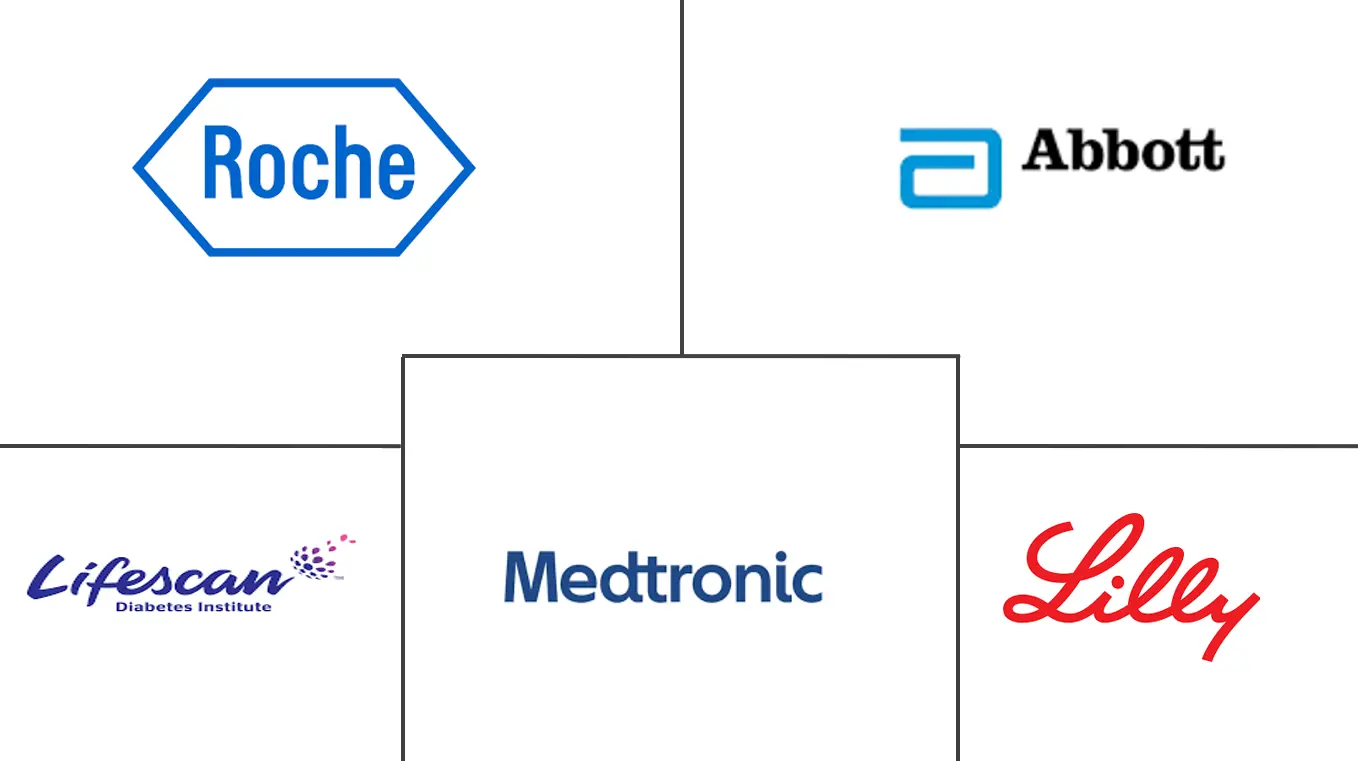
*Disclaimer: Major Players sorted in no particular order |
Brazil Diabetes Care Devices Market Analysis
The Brazil Diabetes Care Devices Market size is estimated at USD 1.06 billion in 2024, and is expected to reach USD 1.37 billion by 2029, growing at a CAGR of greater than 5.62% during the forecast period (2024-2029).
The COVID-19 pandemic has had a notable impact on the diabetes care devices market. Diabetes is a chronic condition demanding self-management and care, which involves regular attention to food, physical activity, blood sugar monitoring, and the use of medications. People with chronic diseases such as diabetes mellitus and obesity have a worse prognosis of COVID-19. Diabetic people are twice more likely to have their comorbid conditions worsened, and consequently to die. The healthcare system must be better organized for more severe cases of COVID-19 as studies suggest that inadequate glycemic control increases the risk of undesired outcomes in diabetic patients with SARS-CoV-2 infection. The prevalence of diabetes in people hospitalized with COVID-19 infection and the recognition that improved glycemic control might improve outcomes and reduce the length of stay in patients with COVID-19 have underlined the importance of diabetes care devices.
According to IDF Diabetes Atlas 2021, 15.7 million adults about 10.5% are currently living with diabetes in Brazil - or one in ten adults. The cost of diabetes-related health expenditure in Brazil is the third highest in the world, at 42.9 billion USD. In addition, 18 million adults around 11.9% have Impaired Glucose Tolerance which places them at high risk of developing type 2 diabetes. 32% of people living with diabetes in Brazil are undiagnosed. Additional data on glycaemic control in Brazil show that only 25% met the therapeutic goal of glycated haemoglobin (HbA1c) <7% before the pandemic, as recommended by the Brazilian Diabetes Society (SBD).
Brazil has implemented a set of reforms over the past to improve the distribution of doctors, develop new forms of service organization, introduce new financing models, and implement a range of quality improvement initiatives and policy frameworks to overcome risk factors such as obesity and emerging pandemic threats. This also highlights opportunities for continuing and expanding innovations in the delivery of diabetes care and the use of diabetes technology.
Brazil Diabetes Care Devices Market Trends
The continuous glucose monitoring segment is expected to witness a healthy growth rate over the forecast period
The continuous glucose monitoring segment is expected to record USD 420 million in revenue with a CAGR of 11.9% over the forecast period.
Continuous Glucose Monitoring Devices are automated glucose monitoring systems with small devices that can be worn on the body and held on by an adhesive patch. The sensor part of the device contains a cannula inserted into the top layer of skin and uses interstitial fluid samples to check glucose levels. Sensors are connected to a transmitter that can send data wirelessly to a dedicated mobile receiving device or smartphone. Continuous glucose monitoring sensors use glucose oxidase to detect blood sugar levels. Sensors are the most important part of continuous glucose monitoring devices. Technological advancements to improve the accuracy of the sensors are expected to drive segment growth during the forecast period.
Using CGMs for people with Diabetes and their caregivers and communities is beneficial for managing their blood glucose and insulin levels to maintain their health outcomes. CGM makes it significantly easier to manage blood glucose levels by decreasing interruptions, allowing better sleep, and improving the mental health of patients or caregivers by reducing the overall mental load of managing Diabetes. CGMs are widely used in children with Type-1, enabling parents to feel safer. It allows other adults to care for their child, giving children more freedom and autonomy in their day-to-day lives and enabling access to more normal experiences and opportunities.
The various initiatives by the Brazilian government are expected to drive the market's growth. The Federal Government of Brazil partnered with numerous private companies to primarily utilize their supply chain (manufacturing, distribution, and retailers) to ensure low device prices. Furthermore, continuous glucose monitoring devices are becoming cheaper with the advent of new technologies, like cell phone integration. It is likely to drive the segment growth during the forecast period.
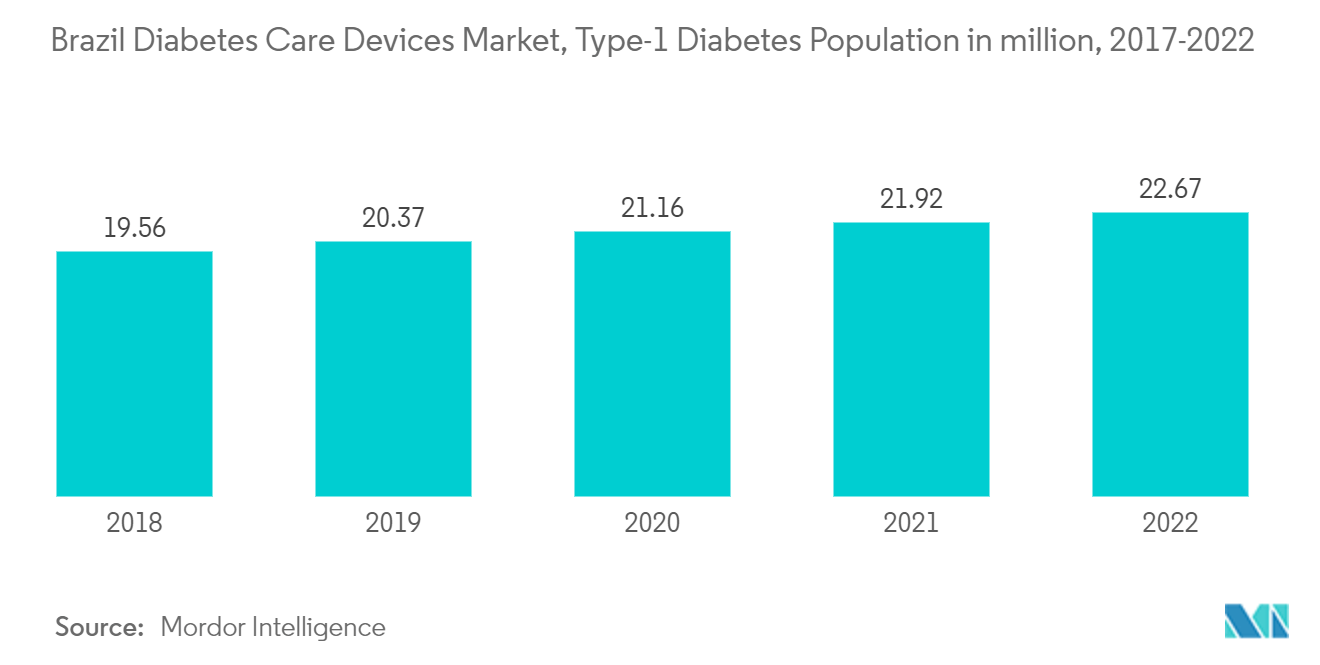
Insulin disposable pens held the highest market share in the management devices segment in the current year
Insulin Disposable Pens occupied the highest market share of about 58% in the management devices segment in the current year.
A disposable insulin pen contains a prefilled amount of insulin. When the pen is empty, it is thrown away. Insulin pens are much smaller and more portable than syringes, including the medicine preloaded into the delivery mechanism. The needles are easy to use and can be disposed of by twisting or snapping. The pens are usually color-coded, making it easier to know which type and how much insulin can be received from them. The disposable insulin pens are considered more consumer-friendly, as they are smaller and less noticeable than the classic vial-and-syringe. These devices are also more portable for consumers. Some pens are smart insulin pens that easily connect to an app on the phone to monitor blood sugar levels. It also reminds the person when to take the next insulin dose.
The high prevalence of diabetes is associated with a significant economic burden. The costs of diabetes are increased in patients with co-morbidities such as hypertension and hyperlipidemia and in patients who develop complications. Costs increase with an increasing number of complications. The Ministry of Health established a list of medications and supplies the Brazilian Health System provides to patients with diabetes. However, their supply is usually insufficient or recommended for optimal patient management across cities. In Brazil, the public health system Sistema Único de Saúde (SUS) is progressively increasing the assistance available for individuals with diabetes. Such factors helped the increased adoption of these products in the Brazilian market.
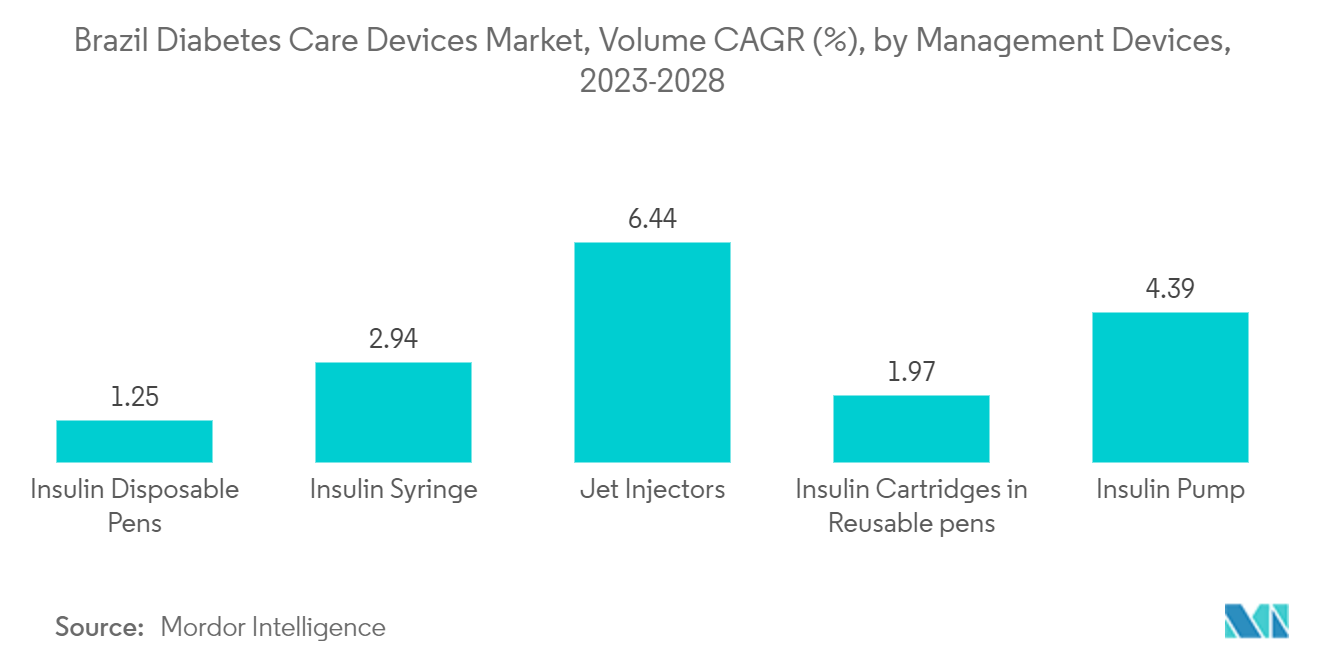
Brazil Diabetes Care Devices Industry Overview
The Brazilian diabetes care devices market is semi-consolidated, with major manufacturers like Roche, Abbott, Novo Nordisk, Dexcom, Medtronic, and other generic players.
Brazil Diabetes Care Devices Market Leaders
-
Abbott Diabetes Care
-
Medtronic PLC
-
Eli Lilly and Company
-
Roche Diabetes Care
-
LifeScan Inc.
*Disclaimer: Major Players sorted in no particular order
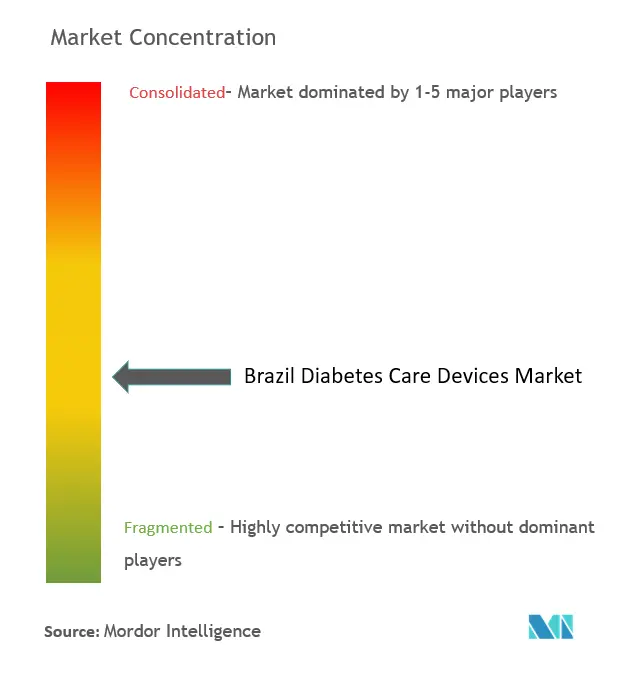
Brazil Diabetes Care Devices Market News
- October 2023: Molex, in collaboration with Phillips-Medisize and GlucoModicum, a Finnish medtech company, has joined forces to develop a cutting-edge continuous glucose monitor (CGM) that is non-invasive and does not require needles.
- August 2022: Abbott and WW International, Inc. (WeightWatchers) announced a strategic partnership to help people with diabetes better understand and manage their diabetes and weight. The companies are working to integrate WeightWatchers' diabetes-tailored weight management program with Abbott's portfolio of FreeStyle Libre products. They want to create a seamless mobile experience that will give people living with diabetes the information and insights needed to make healthy adjustments to their diet, improve their glucose levels, and, ultimately, gain more control of their health.
Brazil Diabetes Care Devices Market Report - Table of Contents
1. INTRODUCTION
- 1.1 Study Assumptions and Market Definition
- 1.2 Scope of the Study
2. RESEARCH METHODOLOGY
3. EXECUTIVE SUMMARY
4. MARKET DYNAMICS
- 4.1 Market Overview
- 4.2 Market Drivers
- 4.3 Market Restraints
-
4.4 Porter's Five Forces Analysis
- 4.4.1 Bargaining Power of Suppliers
- 4.4.2 Bargaining Power of Consumers
- 4.4.3 Threat of New Entrants
- 4.4.4 Threat of Substitute Products and Services
- 4.4.5 Intensity of Competitive Rivalry
5. MARKET SEGMENTATION
-
5.1 Management Devices
- 5.1.1 Insulin Pump
- 5.1.1.1 Technology
- 5.1.1.1.1 Tethered Insulin Pump
- 5.1.1.1.2 Tubeless Insulin Pump
- 5.1.1.2 Component
- 5.1.1.2.1 Insulin Pump Device
- 5.1.1.2.2 Insulin Pump Reservoir
- 5.1.1.2.3 Infusion Set
- 5.1.2 Insulin pens
- 5.1.2.1 Cartridges in Reusable Pens
- 5.1.2.2 Insulin Disposable Pens
- 5.1.3 Insulin Syringes
- 5.1.4 Jet Injectors
-
5.2 Monitoring Devices
- 5.2.1 Self-monitoring Blood Glucose
- 5.2.1.1 Glucometer Devices
- 5.2.1.2 Blood Glucose Test Strips
- 5.2.1.3 Lancets
- 5.2.2 Continuous Glucose Monitoring
- 5.2.2.1 Sensors
- 5.2.2.2 Durables (Receivers and Transmitters)
6. MARKET INDICATORS
- 6.1 Type 1 Diabetes Population
- 6.2 Type 2 Diabetes Population
7. COMPETITIVE LANDSCAPE
-
7.1 Company Profiles
- 7.1.1 Abbott Diabetes Care
- 7.1.2 Roche Diabetes Care
- 7.1.3 LifeScan (Johnson & Johnson)
- 7.1.4 Sanofi
- 7.1.5 Medtronic
- 7.1.6 Novo Nordisk A/S
- 7.1.7 Terumo
- 7.1.8 Eli Lilly
- 7.1.9 Arkray
- 7.1.10 Becton Dickinson
- 7.1.11 Dexcom
- *List Not Exhaustive
-
7.2 Company Share Analysis
- 7.2.1 Self-monitoring Blood Glucose Devices
- 7.2.1.1 Abbott Diabetes Care
- 7.2.1.2 LifeScan
- 7.2.1.3 Others
- 7.2.2 Continuous Glucose Monitoring Devices
- 7.2.2.1 Dexcom
- 7.2.2.2 Abbott Diabetes Care
- 7.2.2.3 Others
- 7.2.3 Insulin Devices
- 7.2.3.1 Medtronic
- 7.2.3.2 Novo Nordisk A/S
- 7.2.3.3 Others
8. MARKET OPPORTUNITIES AND FUTURE TRENDS
** Subject To AvailablityBrazil Diabetes Care Devices Industry Segmentation
Diabetes care devices are the hardware, equipment, and software used by diabetes patients to regulate blood glucose levels, prevent diabetes complications, lessen the burden of diabetes, and enhance the quality of life. The Brazil Diabetes Care Devices Market is segmented into management devices (insulin pumps (Technology and components(insulin pump devices, insulin pump reservoirs, and infusion set)), insulin syringes, insulin cartridges in reusable pens, disposable insulin pens, and jet injectors), and monitoring devices (self-monitoring blood glucose (glucometer devices, blood glucose test strips, and lancets) and continuous glucose monitoring (sensors and durables (receivers and transmitters)))End User (Hospital/Clinics and Home/Personal). The report offers the value (in USD) and volume (in units) for the above segments.
| Management Devices | Insulin Pump | Technology | Tethered Insulin Pump |
| Tubeless Insulin Pump | |||
| Management Devices | Insulin Pump | Component | Insulin Pump Device |
| Insulin Pump Reservoir | |||
| Infusion Set | |||
| Management Devices | Insulin pens | Cartridges in Reusable Pens | |
| Insulin Disposable Pens | |||
| Management Devices | Insulin Syringes | ||
| Jet Injectors | |||
| Monitoring Devices | Self-monitoring Blood Glucose | Glucometer Devices | |
| Blood Glucose Test Strips | |||
| Lancets | |||
| Monitoring Devices | Continuous Glucose Monitoring | Sensors | |
| Durables (Receivers and Transmitters) |
Brazil Diabetes Care Devices Market Research FAQs
How big is the Brazil Diabetes Care Devices Market?
The Brazil Diabetes Care Devices Market size is expected to reach USD 1.06 billion in 2024 and grow at a CAGR of greater than 5.62% to reach USD 1.37 billion by 2029.
What is the current Brazil Diabetes Care Devices Market size?
In 2024, the Brazil Diabetes Care Devices Market size is expected to reach USD 1.06 billion.
Who are the key players in Brazil Diabetes Care Devices Market?
Abbott Diabetes Care, Medtronic PLC, Eli Lilly and Company, Roche Diabetes Care and LifeScan Inc. are the major companies operating in the Brazil Diabetes Care Devices Market.
What years does this Brazil Diabetes Care Devices Market cover, and what was the market size in 2023?
In 2023, the Brazil Diabetes Care Devices Market size was estimated at USD 1 billion. The report covers the Brazil Diabetes Care Devices Market historical market size for years: 2018, 2019, 2020, 2021, 2022 and 2023. The report also forecasts the Brazil Diabetes Care Devices Market size for years: 2024, 2025, 2026, 2027, 2028 and 2029.
Brazil Diabetes Care Devices Industry Report
Statistics for the 2024 Brazil Diabetes Care Devices market share, size and revenue growth rate, created by Mordor Intelligence™ Industry Reports. Brazil Diabetes Care Devices analysis includes a market forecast outlook to 2029 and historical overview. Get a sample of this industry analysis as a free report PDF download.



